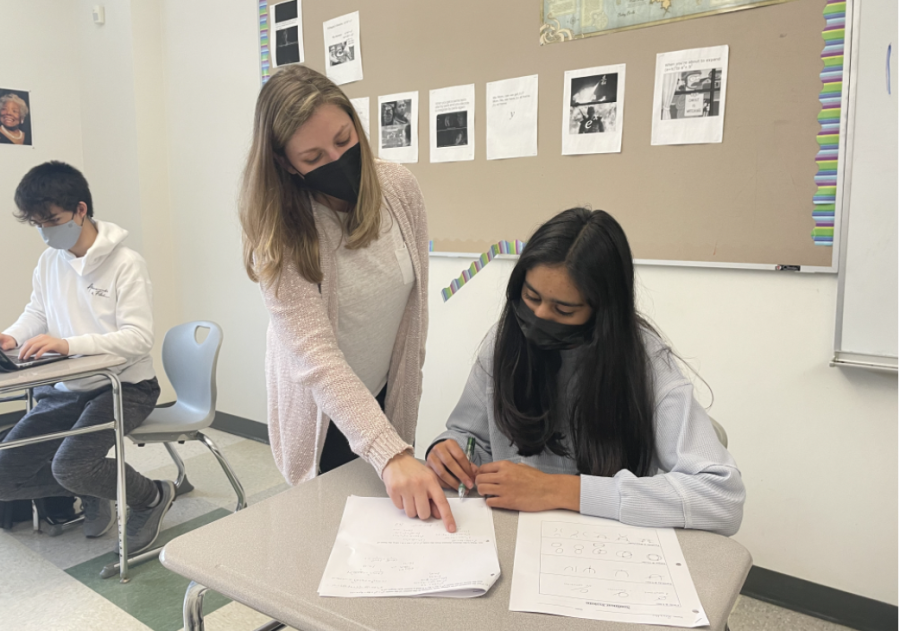The vision for teacher-student relationships at WHS
Math teacher Jacy Anzalone helps a student with their work during class. “Students need help at all different levels, so I just try to keep doing that,” Anzalone said.
March 23, 2022
In the classroom, students aren’t the only ones who have to pay attention and take notes. Teachers have found that in order to get a better understanding of their students as individuals and learners, creating a strong relationship with their students is important. With the addition of unique circumstances like COVD-19, it’s useful for students to thrive if they regard their teachers as approachable and understanding.
For many teachers, an inclusive and comfortable community is essential to the learning environment.
“Just casual conversations, building the comfort and trust in a relationship where I’m not just a teacher, but I’m a person they can approach if they have anything they need to talk about, [can be helpful],” math teacher Jacy Anzalone said.
Some teachers in Wayland say that they strive to bring energy and enthusiasm to their classrooms, setting up an environment where they hope their students feel comfortable asking questions, sparking conversations and applying knowledge to solve problems they encounter. Teachers are aware that the material they teach can be challenging for some and lacking of difficulty for others, so they try to cater to the diverse group of learners.
While high school takes more of an independent environment in contrast to middle school, teachers are still mindful of the fact that students will need assistance in their work. Students who are shifting to a new level of workload—especially the freshman class—are encouraged to use their teachers while adjusting to a new environment.
“I really try to make it a point to speak one-on-one if I notice [that] there is a student that I think should be meeting with me, or that I want to meet with,” history teacher Sarah Lee said. “So, just making that open and reiterating every time I give back a test or a quiz, saying ‘don’t forget, you can revise. You can set up a time with me, I’m always available.’”
In high school, students are pushed to take on a role of independence. Mentors around them put emphasis on taking opportunities, being proactive and staying on top of their work. This can be seen by students taking the first step in an interaction, rather than a teacher approaching the student first.
“What I would want is my students to have a level of comfortability to meet with me beforehand and hammer that stuff out rather than coming after a quiz and being frustrated about a grade,” Lee said. “Building the skills early and working on it with a teacher, rather than seeking [them] out afterwards.”
Anzalone also highlighted the importance of asking for help.
“Don’t be afraid, everyone needs help, and knowing when to ask for help is really an important skill to learn,” Anzalone said. “Just getting them to know that it’s ok to ask for help. I think that offer of just saying ‘hey, if anyone needs help.’’’
Teachers recognize that building a relationship of understanding and trust with students is crucial to a student’s learning in class. With this in mind, they try to strengthen these bonds with students while teaching. Teachers hope that students are also aware of this.
“I think it’s really important for students to find a way to connect with their teachers as much as it’s important for teachers to try and connect with their students,” Lee said.
Students also have an understanding that now they have to be more aware of how they are doing in their classes.
“I definitely have had to be more proactive when I am struggling in class to reach out for help,” freshman Lula Dunkelberg said. “In middle school, the teacher would approach you and make sure that you understand the material, whereas in high school, you have to notice that you are struggling and reach out for help.”
While some classes like core subject classes often have a highly structured curriculum with focussed daily agendas, other classes, such as fine arts classes, are more project based with students working independently.
“I would say that in my branch of the fine arts, my number one objective is to create a space where students feel comfortable expressing themselves in very human ways,” drama teacher Aidan O’Hara said. “I want to create that environment of trust and community.”





![Last Wednesday, the Wayland School Committee gathered to discuss a number of topics regarding the health curriculum and Innovation Career Pathway course. Another large topic of conversation was the ways to potentially mitigate distracting cell phone usage. "These [phones] are going to distract your learning and social relationships," Superintendent David Fleishman said. "That's concrete right there."](https://waylandstudentpress.com/wp-content/uploads/2025/06/Screenshot-2025-06-04-at-9.49.31 PM-1200x886.png)



























![Troy Hoyt finishes the Boston Marathon, running for the Hoyt Foundation. T. Hoyt is the son of Hoyt Foundation CEO Russ Hoyt.
“[Running a marathon] might seem like a big thing, when it’s presented to you at first, but if you break it up and just keep telling yourself, “Yes, you can,” you can start chipping away at it. And before you know it, you’ll be running the whole 26 miles, and you won’t even think twice about it.” T. Hoyt said.](https://waylandstudentpress.com/wp-content/uploads/2025/04/C36E8761-1CBB-452E-9DF2-543EF7B1095E_1_105_c.jpeg)













































